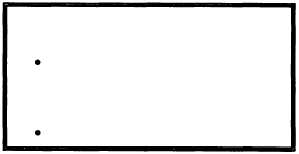The two models of the Mk 37 NVS differ basically
by the type of mount used. Mod 1 is mounted on a
tripod, and Mod 3 is bracket-mounted on the ship's
signal bridge railing. The tripod mount supplied with
the Mod 1 consists of three adjustable legs with a
tripod adapter on top to secure the sight to the mount.
The bracket mount for the Mod 3 is approximately 6
inches by 4 inches by 3.5 inches and is used when
installing the sight at a suitable viewing location. The
bracket mount is capable of positioning the Mk 37
Mod 3 through 360 degrees in train and from -28
degrees to +44 degrees in elevation.
The Mk 37 consists of three functional sections:
objective lens, image intensification tube, and eyepiece.
The objective lens assembly consists of lens
elements and mirrors, which function optically
together and focus the image. The assembly is purged
and sealed in an atmosphere of dry nitrogen to prevent
lens fogging.
The image intensification tube consists of three
stages of fiber optics, each with a photocathode and
phosphor screen amplifying and transferring the
image to the next stage. The adjustment for the
intensifier is set at installation to prevent damage to
the intensifier tube and must not be disturbed.
The eyepiece assembly consists of glass elements
that function to magnify and focus the image on the eye
of the operator. The Mk 37 NVS has seven glass
elements in each eyepiece. The eyepiece assembly is
purged and sealed in an atmosphere of dry nitrogen to
prevent fogging. The Mk 37 NVS is supplied with a
monocular eyepiece; attached to the eyepiece is a rubber
eyeshield, which protects the eyes and aids in security
by covering the areas around the eye. Light leaks are
thereby prevented. In addition to the monocular eyepiece
lens, the Mk 37 NVS is supplied with a binocular
eyepiece lens. This lens allows the observer to use both
eyes, thereby reducing eye fatigue. The binocular
eyepiece allows a small amount of backglow from the
image tube to illuminate the operator but is acceptable
for most surface-ship applications.
A power converter is supplied with the NVS for
convenience in use aboard ship or whenever 115-Vac,
60-Hz power is available. The power converter
consists of the converter unit and cord assembly. It is
sealed in a plastic cylindrical case in a threaded metal
cap and is not repairable. The input connector of the
converter is on the cap end, and the output spring
contact is on the other end. The converter unit screws
into the battery case of the NVS after the battery has
been removed. The 20-foot cord has a converter plug
on one end and a standard shipboard 115-Vac, 60hz
power plug on the other. If the entire cord is not
required to reach the power source, roll up the excess
to avoid creating a walking hazard. A BA 1100/U
6.8-volt disposable mercury battery is also supplied
with the NVS. The battery has a 72-hour
continuous-use life-span and a 2-year shelf life. The
battery is placed in the main housing with the positive
end first. The positive end is easily identified, even in
the dark, by its slightly raised center.
Operation
Before operating the Mk 37 NVS, the operator
needs knowledge and skill in the installation and
setting up of the equipment. Actions required prior to
installation are as follows:
1. Relieve air pressure inside the carrying case by
pressing the core of the relief valve, located near the
carrying handle, before releasing the latches.
2. Cut wire seals by all case latches.
3. Release all case latches and remove the cover.
4. Inventory and inspect the contents to ensure
they are ready for installation.
Installation of the NVS consists of mounting the
sight on the appropriate operational location and
installing the power converter or battery. Locate the NVS
at two positions, one port and one starboard. Ensure
360-degree rotation and that the location provides ample
clearance for operation of the sight in al1 positions of
train and elevation without interference.
The setup consists of removing the NVS from the
storage case. Secure the pintle in the bracket and
locking assembly. If the sight is to be battery operated,
insert the battery and replace the battery cap. If the
power converter is to be used, store the battery cap in
the case and insert the power converter in the battery
housing; rotate it clockwise until it is secure. Connect
the cord between the converter and a 115-Vac, 60-Hz
power source. The sight is now ready for operation.
CAUTION
Do not leave the battery in the equip-
ment during storage, or corrosive damage
may result.
Do not remove the cover in daylight.
2-15

